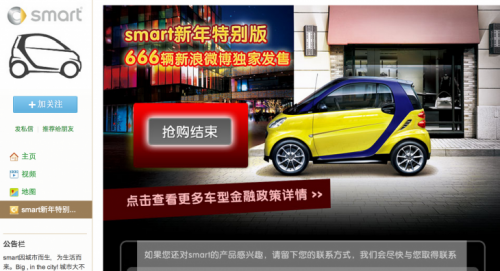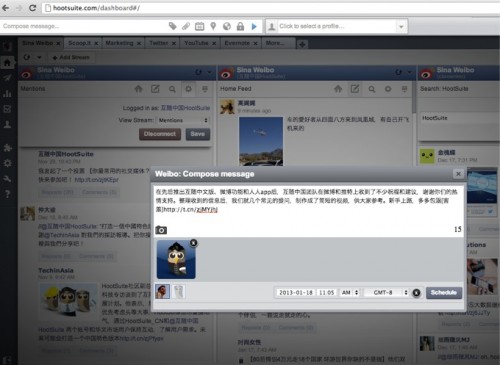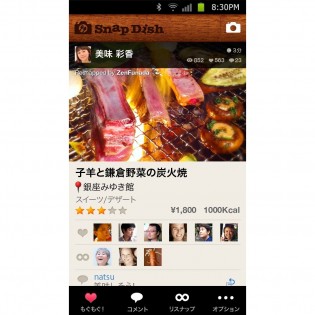We Are Social Asia Tuesday TuneUp #63
Mercedes-Benz sells limited edition Smart Cars on Sina Weibo
Could this be the sign of things to come? Mercedes-Benz launched a Weibo app last Friday to sell 666 units of special edition smart cars priced at US$12,700 (S$25,328) each. For the first time, the lifestyle arm of the German luxury carmaker is collaborating with Chinese jewelry designer Wan Baobao for the special Lunar New Year edition. To celebrate the Lunar Year of the Snake, the car will bear a snake-shaped logo tag set against a bright yellow and deep blue colour scheme. The company shared that this innovative effort is not driven purely by sales but a means of reaching out and engaging with customers via social media. The smart car division is no stranger to the e-commerce marketplace, having set a record in 2010 for selling 205 cars within four hours via group buying on online marketplace, Taobao.
HootSuite rolls out updates for Sina Weibo and Renren
Last October, we mentioned that HootSuite has rolled out support for Sina Weibo and Traditional Chinese. In the latest update, the social media management dashboard has added new features for Sina Weibo. These include scheduling of posts in addition to allowing enterprise customers to add multiple accounts and save keyword searches for monitoring purposes. The new features have also been rolled out for the Renren plugin on HootSuite. The latest update also allows tracking of photos and shares on the Facebook-like platform via new streams. Industry watchers anticipate that HootSuite will eventually support Sina’s competitor, Tencent’s social networks, in an upcoming development.
Japanese photosharing app adds cute Valentine’s Day stamps
Trust the Japanese app makers to come up with saccharine apps and features to charm the socks off hopeless romantics. In its latest incarnation, Camely, a Japanese Instagram-like app has upped the cute factor by allowing users to add a range of Valentine-themed stamps in addition to the existing suite of filters, frames, text effects and stamps designed to give you a sugar-rush of the app variety.
Burpple, food photo sharing app, rolls out offline uploads
Singapore-based Instagram-esque Burpple has rolled out an offline upload feature to support users who are keen to share their food photos but have limited mobile data access. The offline feature works by allowing users to upload images to their Burpple boxes and storing the photos in cache for publishing to the service when the phone is connected to the web. For a visual guide on the feature, check out the video below.
SnapDish now available in 7 more languages & on Kindle Fire
While some restaurants are banning food photography, it may not be the end of the road for foodies intent on sharing photos of their meals. SnapDish, a Japanese photosharing app for food lovers, is now available on Kindle Fire and supports an additional seven new languages on top of the existing four, which are English, Chinese, Japanese and Korean. As 30 percent of the app downloads originate outside of Japan, app maker Vuzz’s latest release is a timely development as they roll out support for Thai, Indonesian, French, Spanish, Italian, German and Portuguese. Currently available on iPhone and Android, the latest Kindle Fire release is expected to give the app a boost in users from North America.
Marketers need to apply more budget to social
Research by Warc has found that of 800 award-winning marketing case studies from the last year, those that included a social element were more on the whole shorter, lower-budget and less likely to display proof of effectiveness. Of the cases studied, those with a social element made up over 55%, but only 51% won the ‘top industry awards’. 44% were found in the lowest budget category (below $500,000), of which only 28% won gold awards. The research shows a link between spend, duration and effectiveness, which in turn displays how it is important for marketers to invest in social as a more serious marketing tool and less of an experiment in order to be truly effective.
Luxury brands investing more heavily in social
As if taking Warc’s advice, luxury brands have been reported by eMarketer to be upping their social budgets; 72% of 130 marketing executives surveyed by Worldwide Business Research and ShopIgniter will be increasing their social budget in 2013. 95% said they were already actively engaging customers on Facebook, making it the most popular social platform, with Twitter in second place with 85%. Perhaps unsurprisingly, Pinterest came in third with 60%, as the visual nature of the site is well suited to the marketing and conversation styles normally adopted by luxury brands.

The Fastest Growing Facebook Countries
Socialbakers have conducted research into the ten fastest growing countries on Facebook. Over the course of the year, 29,723,750 joined the network in Brazil, making it the fastest growing and the second biggest Facebook country overall. India came in second, followed by Japan, Indonesia and Mexico. Interestingly, the United States and Germany both made the top ten, suggesting that there is still room for growth in Western countries.

Facebook launches conversion tracking tool for all ad accounts
Open to some of Facebook’s top advertisers for over a year, the network has now rolled out its conversion tracking feature to all advertiser accounts. This allows marketers to embed a unique piece of code on page on their website, which will track the number of conversions, such as checkouts or registrations.
Twitter valued at $9 billion
An offer to Twitter’s staff by BlackRock has valued the company at more than $9 billion. The asset management firm have made an offer of $80 million to purchase shares from some of Twitter’s earliest staff, while the network itself will not raise any capital from the deal. The valuation marks a decrease from the $11 billion calculated from some deals at the end of last year. However, considering the problematic nature of Facebook’s IPO, as well as a difficult financial period for other Silicon Valley firms, the large value should be encouraging to Twitter.
Twitter launch Vine, a video sharing app
Twitter have released a new app this week: a video sharing app for iPhone and iPod touch called Vine. In keeping with the microblogging spirit, videos are limited in length, with some great examples shown on the network’s blog. Users can share 6 seconds of looping video, establishing the service somewhere between a GIF and a full film, which will begin playing simply when users click ‘expand tweet’.
Steak tartare in six seconds. vine.co/v/bOIqn6rLeIDvia @dhof
— dick costolo (@dickc) January 23, 2013
A preview tweet showed Twitter CEO Dick Costolo showing his followers how to make steak tartare.
As for how to use it, this useful graphic explains the basic process:

The service has been reviewed positively by The Verge, who argue that it takes away a number of the problems of shooting amateur video, with the ‘tap to shoot’ functionality making it easy to record a montage. They cite the difficulty of shooting longer shots, but consider how this may well be intentional, encouraging short, quickly-cut videos that look good on a Twitter feed. Another problem may be created by Facebook, who almost instantly cut off the app’s access to the “find people” feature, which allowed users to locate and connect with their Facebook friends.
Naturally, there is already interest in how the service can be utilised by brands. AdAge have reported a mixture of excitement and scepticism throughout the advertising world. There has been a very high initial takeup and within a day Vine had become the top-ranked social media app on the Apple app store, ranking at 13th overall. However, they consider worries by certain agencies about current problems with the app, including an unfinished feel and some technical hitches, as well as concern that the initial hype may die down without giving way to longevity. Nevertheless, brands have taken to the service already, with Urban Outfitters and Gap amongst those to have started experimenting. There is a long way to go before we can assess whether or not Vine has become a successful part of the social landscape, but it certainly has potential as an interesting medium for use, in both the personal and marketing spheres.
Twitter increases the cost of Promoted Trends for the Super Bowl
It’s probably the biggest event in US sport and retains a large audience even in those countries with little interest in American Football during the rest of the year. No wonder, then, that Twitter are looking to capitalise on the increased interest in ‘Promoted Trends’ during this year’s Super Bowl. Over the past year, brands have been able to purchase a ‘Promoted Trend’ for $120,000 a day. However, during the Super Bowl, this figure is likely to be significantly higher, which displays both the importance of Twitter as a conversation network during big sporting events and the interests of the company in attempting to monetise the service.
LinkedIn to turn off ‘Answers’ at the end of January
Answers, the LinkedIn forum that allows users to respond to one another’s questions, is set to be turned off at the end of the month. Econsultancy have reported the official reasoning behind this:
As of Jan. 31, LinkedIn Answers will be retired from LinkedIn. We will be focusing our efforts on the development of new and more engaging ways to share and discuss professional topics across LinkedIn
They speculate that this is likely to mean an increased push towards the use of groups and pages. If this is the case, there is a potential issue in terms of the number of spam posts that currently occupy these areas. Whilst ‘Answers’ was by no means a perfect service and itself included posts by those with little actual expertise, it will be interesting to see the extent to which it is improved upon by its replacement.
Quora introduce blogs
Question-and-answer website Quora has released a blog service, with which it hopes to provide an audience for writers currently lacking one and help others to expand theirs further. The idea is that, as Quora naturally organises writing into relevant topics, your piece is far more likely to be found by the audience you desire. The service will launch on both desktop and mobile, with an emphasis on simple, striking presentation as shown below:

Coca Cola unveil social Super Bowl campaign
Coca Cola are set to follow last year’s incredibly successful Super Bowl polar bears with a social campaign called ‘Mirage’. They have produced a video, shown below, that depicts three different sets of teams racing through the desert towards a giant bottle of Coca Cola. Leading up to the TV advert, fans online can vote for who they want to reach the Coke first and sabotage their competitors by watching and interacting with a variety of content on networks including Facebook, Twitter, Tumblr, Instagram and YouTube, of which one video notably includes a partnership with Domino’s Pizza. By sharing content, fans can unlock rewards including coupons for bottles of Coca Cola. After the game, the final video will reveal which of the three groups has been successful in the race.
Target promote Everyday Collection with ‘Tweet to Runway’
Target are promoting their ‘Everyday Collection’ with an event that encourages fans to Tweet statemenets about their everyday lives, accompanied by the hashtag #Everydayshow. Target then choose their favourites and have them read out by models on a runway. They have produced video content depicting some of the best examples:
Capri Sun involve mummy bloggers in latest campaign
Drinks brand Capri Sun are utilising the power of mum in their latest campaign, which features a bespectacled boy named Jack ‘Seizing the Day’ by taking part in a variety of extreme activities, whilst, of course, enjoying a Capri Sun. Mums are then encouraged to enter a picture of their child doing the same, encouraged by the phrase “We know your kids are extraordinary, too” and the potential $2,500 prize. Blogger outreach plays a large part in the idea, with influential mummy bloggers being engaged by the brand to write articles about their own children ‘seizing the day’. Despite the solid, interesting campaign, it seems as though they may have missed a trick: there is as yet no mention of the pun ‘Capri diem’.
We Are Social create ‘Boastcards’ campaign for Expedia
We Are Social have created an activation for Expedia Australia and New Zealand aimed at promoting their summer sale. They have constructed a fully customisable template for fans to produce their own ‘Boastcards’, which they can share with friends to show off about their trip so far – the first 1,000 users are able to do so physically. By uploading information on their location, fans are also offered the opportunity to view other Boastcards from the region, as well as deals for their current spot. On top of this, there is the possibility to enter a competition with a grand prize of $2,000. Alica Kroupa, Account Director at We Are Social, said:
We wanted to generate a buzz about the Expedia Summer Sale among the Expedia Facebook community as well as other Facebook users in their networks. The Boastcard app is a great way of creating fantastic user-generated content likely to be of interest to anyone with an interest in travel.
Justin Bieber now the most followed person on Twitter
Justin Bieber has overtaken Lady Gaga to become the most followed person on Twitter, with over 33 million followers. The Mirror also points out that the figure amounts to more than the combined follower total of Harry Styles and Barack Obama, which may be the world’s strangest ever combined metric.
French Government replace the word ‘hashtag’ with ‘mot-dièse’
The French Government have decided to use their own French-language word for the hashtag, labelling it as a mot-dièse in all official literature going forward. It literally translates as ‘sharp word’, alluding to the musical sharp symbol. Some have argued that this may be problematic as the symbols are slightly different (# and ♯) but unless the people of France are posting a great deal of musical notation to Twitter, we shouldn’t imagine there will be too much confusion.



